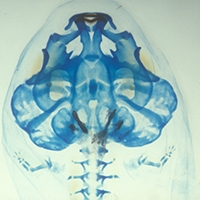Citation:
| 631 KB |
Abstract:
Direct development is a specialized reproductive mode that has evolved repeatedly in many different lineages of amphibians, especially anurans. A fully formed, albeit miniature adult hatches directly from the egg; there is no free-living larva. In many groups, the evolution of direct development has had profound consequences for cranial development and morphology, including many components that are derived from the embryonic neural crest. Yet, the developmental bases of these effects remain poorly known. In order to more fully characterize these changes, we used three molecular markers to analyze cranial neural crest-cell emergence and migration in the direct-developing frog, Eleutherodactylus coqui: HNK-1 immunoreactivity, Dlx protein expression, and cholinesterase activity. Our study validates and extends earlier results showing that the comprehensive changes in embryonic cranial patterning, differentiation, and developmental timing that are associated with direct development in Eleutherodactylus have not affected gross features of cranial neural crest biology: the relative timing of crest emergence and the number, configuration and identity of the principal migratory streams closely resemble those seen in metamorphic anurans. The three markers are variably expressed within and among neural crest-cell populations. This variation suggests that determination of cranial neural crest-cells may already have begun at or soon after the onset of migration, when the cells emerge from the neural tube. It is not known how or even if this variation correlates with differential cell lineage or fate. Finally, although HNK-1 expression is widely used to study neural crest migration in teleost fishes and amniotes, E. coqui is the only amphibian known in which it effectively labels migrating neural crest-cells. There are not enough comparative data to determine whether this feature is functionally associated with direct development or is instead unrelated to reproductive mode.
Notes:
592HRTimes Cited:14Cited References Count:86






